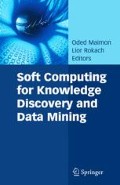The learning of transparent models is an important and neglected area of data mining. The data mining community has tended to focus on algorithm accuracy with little emphasis on the knowledge representation framework. However, the transparency of a model will help practitioners greatly in understanding the trends and idea hidden behind the system. In this chapter, a random set based knowledge representation framework for learning linguistic models is introduced. This framework is referred to as label semantics and a number of data mining algorithms are proposed. In this framework, a vague concept is modelled by a probability distribution over a set of appropriate fuzzy labels which is called as mass assignment. The idea of mass assignment provides a probabilistic approach for modelling uncertainty based on pre-defined fuzzy labels.
Access this chapter
Tax calculation will be finalised at checkout
Purchases are for personal use only
Preview
Unable to display preview. Download preview PDF.
References
J.F. Baldwin, T.P. Martin and B.W. Pilsworth (1995), Fril-Fuzzy and Evidential Reasoning in Artificial Intelligence. John Wiley & Sons Inc, 1995.
J. F. Baldwin, J. Lawry and T.P. Martin (1997), Mass assignment fuzzy ID3 with applications. Proceedings of the Unicom Workshop on Fuzzy Logic: Applications and Future Directions, London pp. 278-294, 1997.
J. F. Baldwin and D. Xie (2004), Simple fuzzy logic rules based on fuzzy decision tree for classification and prediction problem, Intelligent Information Processing II, Z. Shi and Q. He (Ed.), Springer, 2004.
C. Blake and C.J. Merz (2007). UCI machine learning repository. http://www.ics. uci.edu/∼mlearn/MLRepository.html, 2007.
M. Drobics, U. Bodenhofer and E. P. Klement 2003, FS-FOIL: an inductive learning method for extracting interpretable fuzzy descriptions, International Journal of Approximate Reasoning, 32: pp. 131-152, 2003.
S. R. Gunn (1998), Support vector machines for classification and regression. Technical Report of Dept. of Electronics and Computer Science, University of Southampton, 1998.
E. Hullermeier (2005), Fuzzy methods in machine learning and data mining: status and prospects, to appear in Fuzzy Sets and Systems, 2005.
R. Hyndman and M Akram (2005), Time series Data Library. Monash University, 2007.
C. Z. Janikow 1998, Fuzzy decision trees: issues and methods. IEEE Trans. on Systems, Man, and Cybernetics-Part B: Cybernetics, Vol. 28, No. 1, 1998.
R. C. Jeffrey 1965, The Logic of Decision, Gordon & Breach Inc., New York, 1965.
J. Lawry, J. Shanahan, and A. Ralescu (2003), Modelling with Words: Learning, fusion, and reasoning within a formal linguistic representation framework. LNAI 2873, Springer-Verlag, 2003.
J. Lawry (2001), Label semantics: A formal framework for modelling with words. Symbolic and Quantitative Approaches to Reasoning with Uncertainty, LNAI 2143: pp. 374-384, Springer-Verlag, 2001.
J. Lawry (2004), A framework for linguistic modelling, Artificial Intelligence, 155: pp. 1-39, 2004.
J Lawry (2006), Modelling and Reasoning with Vague Concepts, Springer, 2006.
C. Olaru and L. Wehenkel (2003), A complete fuzzy decision tree technique. Fuzzy Sets and Systems. 138: pp.221-254, 2003.
Y. Peng, P. A. Flach (2001), Soft discretization to enhance the continuous decision trees. ECML/PKDD Workshop: IDDM.
H. Prade, G. Richard, and M. Serrurier (2003), Enriching relational learning with fuzzy predicates, N. Lavrac, et. al (Eds.): Proceedings of PKDD, LNAI 2838, pp. 399-410.
Z. Qin and J. Lawry 2004, A tree-structured model classification model based on label semantics, Proceedings of the 10th International Conference on Information Processing and Management of Uncertainty in Knowledge-based Systems (IPMU-04), pp. 261-268, Perugia, Italy.
Z. Qin and J. Lawry (2005a), Hybrid Bayesian estimation trees based on label semantics, L. Godo (Ed.), Proceedings of Eighth European Conference on Symbolic and Quantitative Approaches to Reasoning with Uncertainty, Lecture Notes in Artificial Intelligence 3571, pp. 896-907, Springer.
Z. Qin and J. Lawry 2005b, Decision tree learning with fuzzy labels, Information Sciences, Vol. 172/1-2: pp. 91-129.
Z. Qin and J. Lawry 2005c, Prediction trees using linguistic modelling, the Proceedings of International Fuzzy Association World Congress-05, Beijing, China, September.
Z. Qin and J. Lawry 2005d, Linguistic rule induction based on a random set semantics, the Proceedings of International Fuzzy Association World Congress05, Beijing, China.
Z. Qin and J. Lawry 2007, Fuzziness and performance: an empirical study with linguistic decision trees. To appear in IFSA-2007, Cuncun, Mexico.
J. R. Quinlan 1986, Induction of decision trees, Machine Learning, Vol 1: pp. 81-106.
J. R. Quinlan 1993, C4.5: Programs for Machine Learning, San Mateo: Morgan Kaufmann.
J. R. Quinlan 1990, Learning logical definitions from relations, Machine Learning, 5: 239-266.
N. J. Randon and J. Lawry 2006, Classification and query evaluation using modelling with words, Information Sciences, Special Issue - Computing with Words: Models and Applications, Vol. 176: pp 438-464.
Pei Wang 2004, The limitation of Bayesianism, Artificial Intelligence 158(1): pp. 97-106.
D. Xie (2005), Fuzzy associated rules discovered on effective reduced database algorithm, Proceedings of IEEE-FUZZ, pp. 779-784, Reno, USA, 2005.
L. A. Zadeh 1965, Fuzzy sets, Information and Control, Vol 8: pp. 338-353.
L. A. Zadeh 1996, Fuzzy logic = computing with words, IEEE Transaction on Fuzzy Systems. Vol. 4, No. 2: pp. 103-111.
L. A. Zadeh, Toward a perception-based theory of probabilistic reasoning with imprecise probabilities, Journal of Statistical Planning and Inference, Vol. 105: pp. 233264.
L.A. Zadeh (2003), Foreword for modelling with words, Modelling with Words, LNAI 2873, Ed., J. Lawry, J. Shanahan, and A.Ralescu, Springer.
L.A. Zadeh 2005, Toward a generalized theory of uncertainty (GTU) an outline, Information Sciences, Vol. 172/1-2, pp. 1-40.
Author information
Authors and Affiliations
Editor information
Editors and Affiliations
Rights and permissions
Copyright information
© 2008 Springer Science+Business Media, LLC
About this chapter
Cite this chapter
Qin, Z., Lawry, J. (2008). Knowledge Discovery in a Framework for Modelling with Words. In: Maimon, O., Rokach, L. (eds) Soft Computing for Knowledge Discovery and Data Mining. Springer, Boston, MA. https://doi.org/10.1007/978-0-387-69935-6_11
Download citation
DOI: https://doi.org/10.1007/978-0-387-69935-6_11
Publisher Name: Springer, Boston, MA
Print ISBN: 978-0-387-69934-9
Online ISBN: 978-0-387-69935-6
eBook Packages: Computer ScienceComputer Science (R0)

